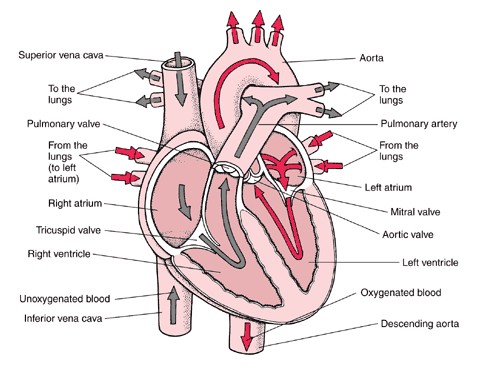Cards In This Set
| Front | Back |
|
Structural and functional relationship between the respiratory and circulatory systems
|
respiratory (gill, trachea,lungs)-collection of cells, tissue and organs responsible for gas exchange between the individual and its environment -structures for conduction air or water to a surface where gas exchange takes place (tubing)
circulatory (heart, system of vessels)-takes oxygen from respiratory-responsible for moving O2, CO2 and other materials around the body-through circulation, the dissolved O2 and CO2 are transported through out the body. |
|
Distinguish between open and closed circulatory systems and name the animals that have each
|
open circulatory-blood is not contained 100% inside vessels-Fish, insects
Closed circulatory:-blood is 100% inside high pressure vessels |
|
Describe how the insect tracheal system delivers oxygen through the body.
Experiment 984 |
-series of tubes extending throughout the body
-tips of trachea are tiny, fluid filled and highly branched -transports air close enough to cells for gas exchange to take place directly across their plasma membrane - insects do not use their circulatory system to transport gases to and from tissues EXPERIMENT (pumping of oxygen by moving)-trachea of flying insects are sandwiched between muscles when muscles contract/relax tracheae contract and expand in response -air moves through spiracles -muscular contractions help ventilate the tracheal system |
|
State a hypothesis to explain why giant insects existed 300 million years ago, but could not possibly exist today
|
Giant insects survived/thrived because atmospheric concentration of oxygen was high
-by raising oxygen concentration the distance it has to travel would not be a barrier -now that oxygen concentrations are lower the long distance the oxygen has to travel is harder for teh oxygen and carbon dioxide to travel in and out -insects are small to account for distance and decreased oxygen concentration |
|
Define Fick's Lawdescribe how it relates to the structure of vertebrate respiratory surfaces
|
The rate of diffusion of a gas depends on 5 parameters:
1. solubility of gas in aqueous film lining the gas exchange surface 2. Temperature 3. surface area available for diffusion 4. Difference in partial pressures of the gas across the gas-exchange surface 5. Thickness of the barrier to diffusion Gills-present large surface area -countercurrent flow makes gills efficient at extracting O2 from H2O because it ensure that the difference in partial pressure of O2 and CO2 in water vs blood is large over the entire gas-exchange surface Lungs-amount of surface area varies greatly Frogs/Amphibians:-lung simple sac Humans-alveoli makes 40x more surface area Ventilation-vertebrates-actively ventilate their lungs by pumping air via muscular contractions |
|
Erythrocytes?Leukocytes?Platelets?
|
1. (red blood cell) carry oxygen 2. (white blood cell) immune system3. clotting
|
|
How are oxygen and carbon dioxide carried in the blood?
|
Oxygen is carried on hemoglobin (4= 100%)-carried to tissues (lowers Oxygen concentration to 75%)-Each drop off lowers oxygen concentration until you reach 0%
Carbon Dioxide-dissolves in plasma, binds to plasma/hemoglobin but not on iron like oxygen -CO2 combines with H2O to produce carbonic acid -dissociates in HCO3- and H+ lowering the pH in the plasma and red blood cells -hydrogen ions combine with hemoglobin |
|
Interpret the oxygen-hemoglobin dissociate curve, and identify the situations in which the curve would be shifted to the left or right?
|
Saturated hemoglobin (4 oxygen)-as the red blood cells move through the tissues(low O2 concentrations)-hemoglobin is likely to give off an oxygen -as it starts to give off oxygen, bonds weaken between oxygen and hemoglobin molecule and it continues to give off oxygens (weaken the bonds each time)
Shifted to right when exercise (INCREASE H+ WHICH LOWERS PH CAN'T CARRY AS MUCH OXYGEN)--Bohr shift--during exercise shifted to the left when excess oxygen straight line on curve?--if bond strength did not change |
|
Describe the major types of blood vessels
|
Arteries: carry blood away from the heartVeins: carry blood toward the heart Capillaries: thing vessels that join arteries and veins (thin enough for gas exchange)
|
|
Describe the flow of blood through the human hear tin the proper order
|
 Blood from body -- superior or inferior vena cava--- right atrium--- right ventricle---pulmonary artery---lungs---pulmonary veins----left atrium---left ventricle----aorta---body |
|
How does atherosclerosis lead to myocardial infarction?
|
Artherosclerosis: build up of cholestrol which makes heart muscle cell not receive enough oxygen, eventually killing the cell (due to hypoxial)
--can happen throughout the body --if it happens in a coronary artery it called myocardial infarction-death of tissues in the heart due to lack of oxygen |
|
Identify the number of chambers in the hearts of the major vertebrate groups and describe the functional consequences of differences in number of chambers.
|
Fish-- 2 chambersAmphibians/Reptiles--3 chambers (not able to get as high blood oxygenated blood--- MIXED)(except crocs)-- 4 chambers Birds/Crocs/Mammals--- 4 chambers-completely divided ventricles-divided pulmonary and systemic circuits
|
|
Not advantage of breathing air?
|
Breathing air leads to high evaporation rates -- moist surface in order to keep diffusion going
|
|
Open circulatory system is less efficient in what respect?
|
Hard to deliver O2 to specific tissues
|



